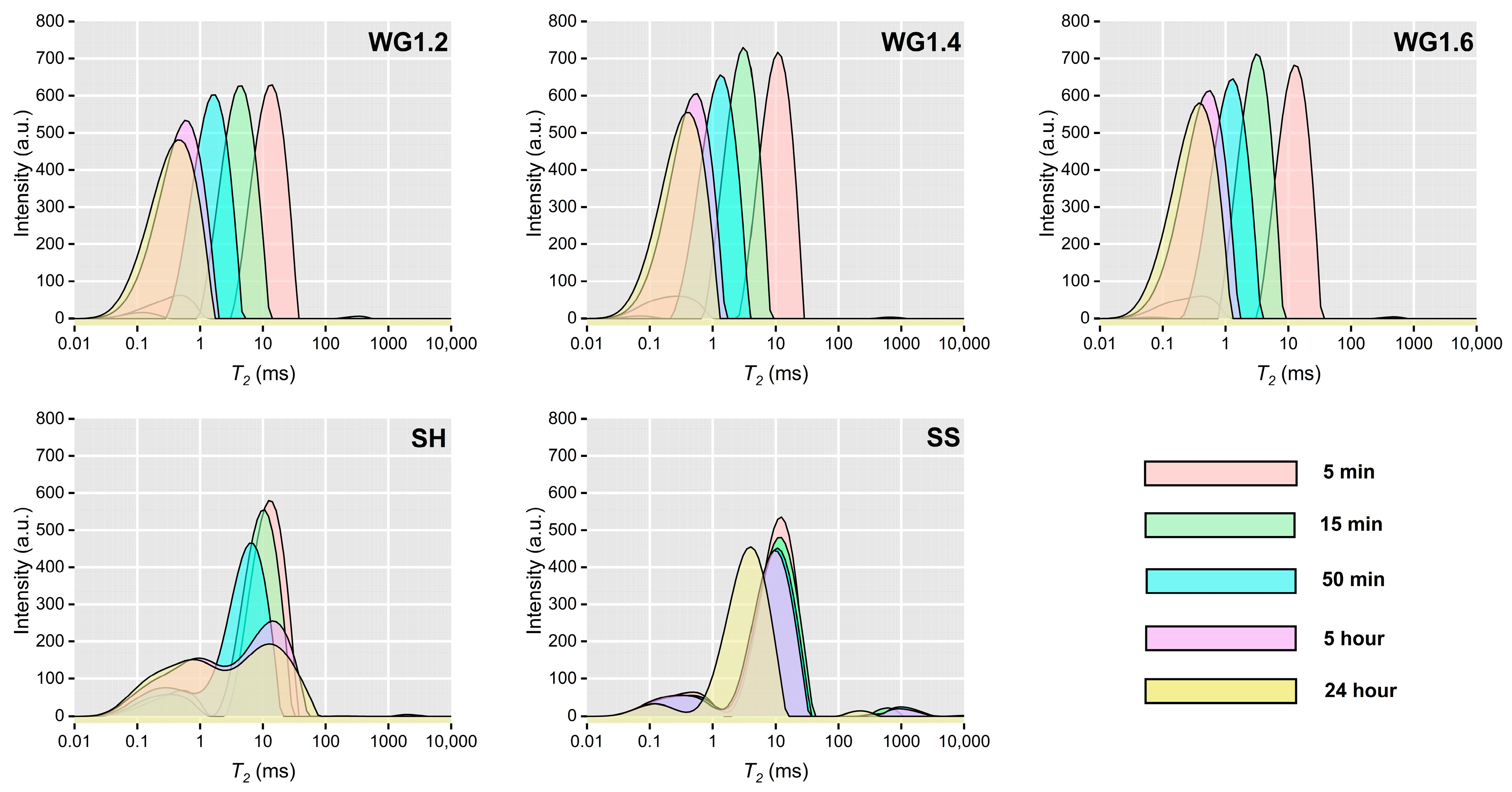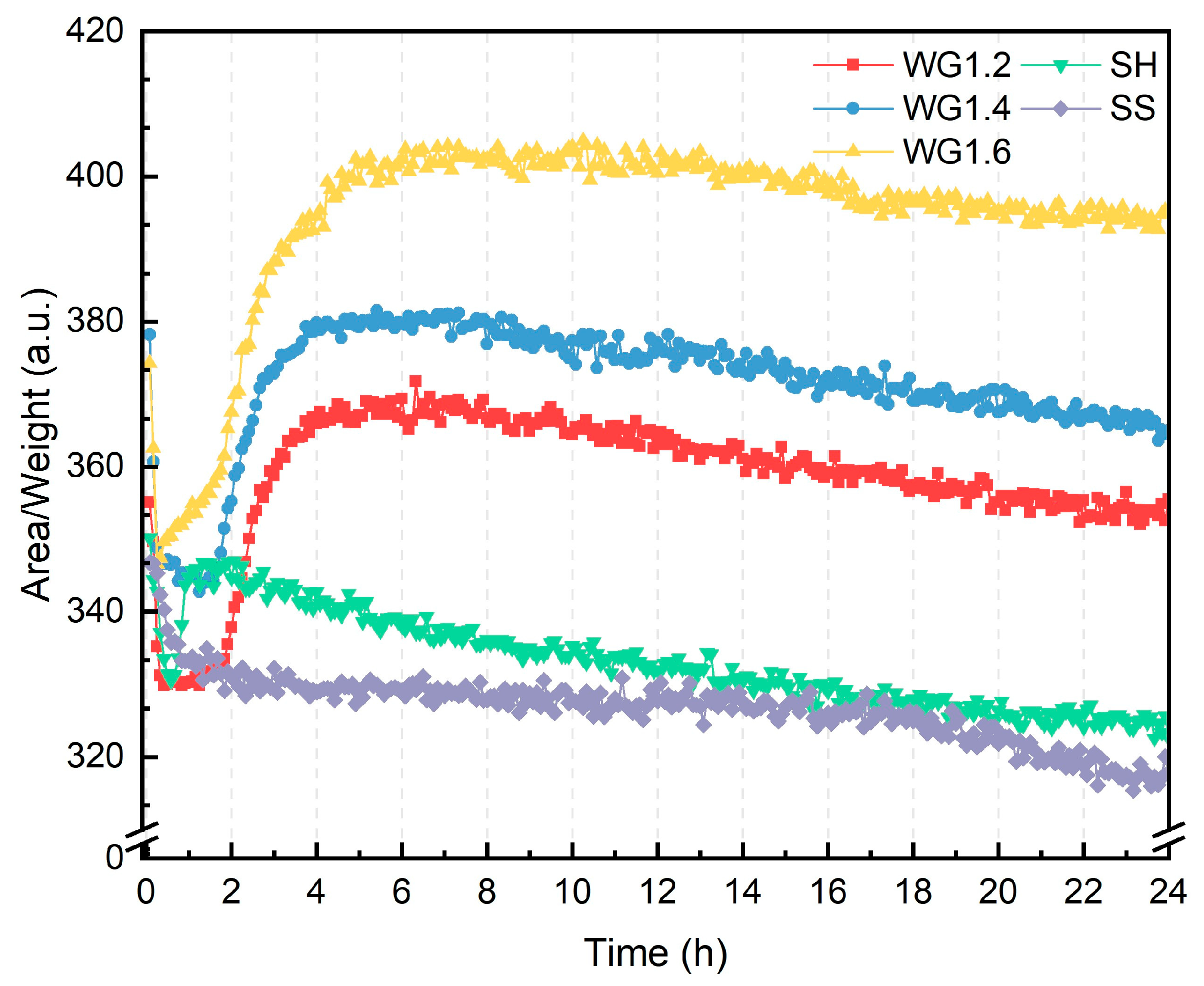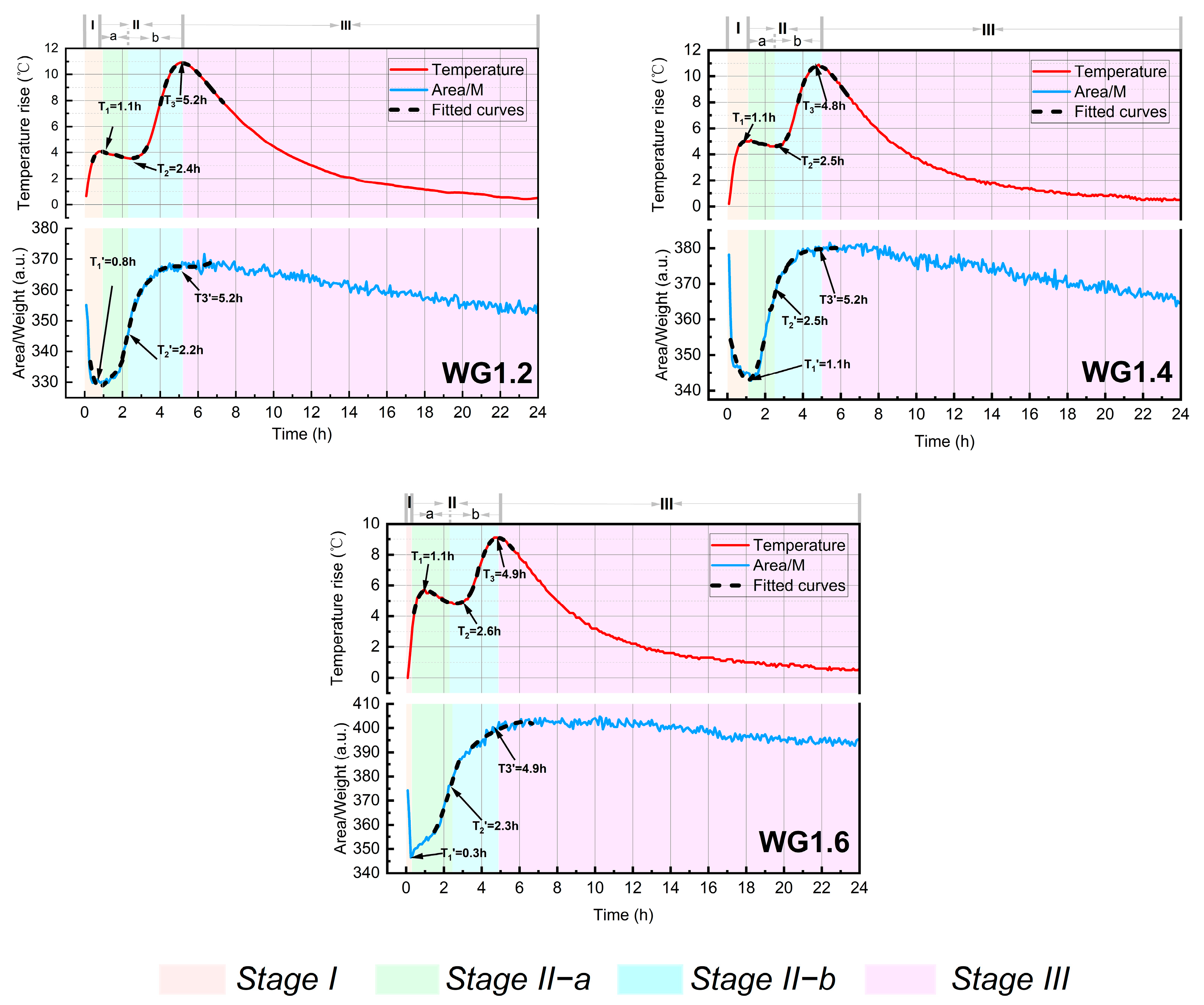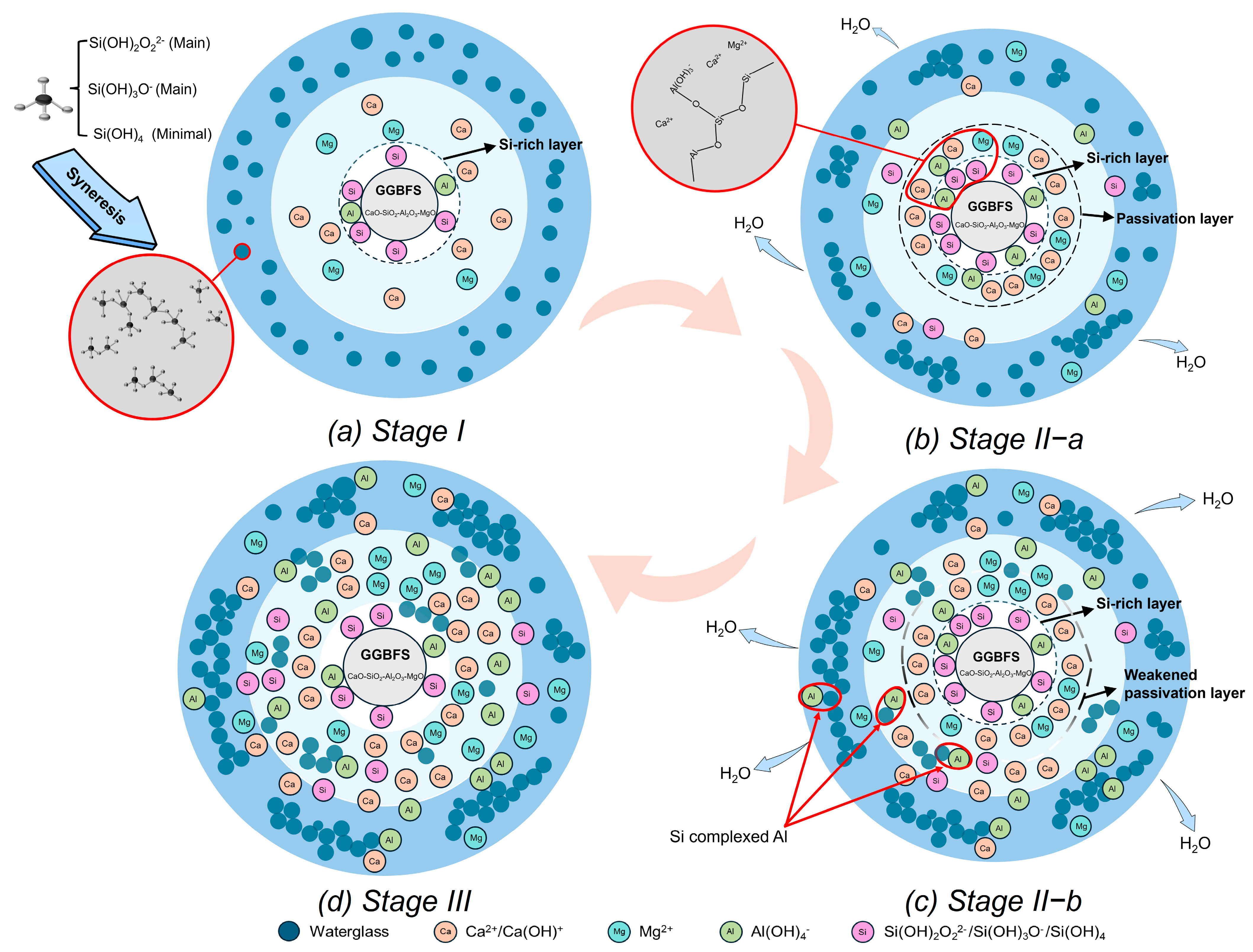Monitoring Early-Stage Evolution of Free Water Content in Alkali-Activated Slag Systems by Using 1H Low-Field NMR
Abstract
:1. Introduction
2. Materials and Methods
2.1. Materials
2.2. Mixture Proportions and Mixing Procedures
2.3. H Low-Field NMR
2.4. Isothermal Calorimetry
3. Results and Discussions
3.1. Transverse Relaxation Time (T2) Distribution of AAS Pastes
3.2. Total T2 Peak Area and Relative Free Water Content
3.3. Evolution of Relative Free Water Content and Exothermic Hydration
4. Conclusions
Author Contributions
Funding
Data Availability Statement
Conflicts of Interest
References
- Dai, X.; Aydin, S.; Yardimci, M.Y.; De Schutter, G. Rheology and structural build-up of sodium silicate-and sodium hydroxide-activated GGBFS mixtures. Cem. Concr. Compos. 2022, 131, 104570. [Google Scholar] [CrossRef]
- Zhuang, K.; Liu, B.; Fang, Y.; Guo, Y.; Shuai, L.; Dong, B.; Long, W.; Xing, F. Is electrodeless resistivity method suitable for monitoring the early-age reaction of Na2SiO3-activated slag? Mechanism and application. Constr. Build. Mater. 2021, 272, 121719. [Google Scholar] [CrossRef]
- Fang, Y.; Zhuang, K.; Zheng, D.; Guo, W. The influence of alkali content on the hydration of the slag-based geopolymer: Relationships between resistivity, setting, and strength development. Polymers 2023, 15, 518. [Google Scholar] [CrossRef]
- Yang, J.; Sun, Z.; De Belie, N.; Snoeck, D. Internal curing and its application to alkali-activated materials: A literature review. Cem. Concr. Compos. 2023, 145, 105360. [Google Scholar] [CrossRef]
- Sun, Y.; de Lima, L.M.; Rossi, L.; Jiao, D.; Li, Z.; Ye, G.; De Schutter, G. Interpretation of the early stiffening process in alkali-activated slag pastes. Cem. Concr. Res. 2023, 167, 107118. [Google Scholar] [CrossRef]
- Živica, V. Effects of type and dosage of alkaline activator and temperature on the properties of alkali-activated slag mixtures. Constr. Build. Mater. 2007, 21, 1463–1469. [Google Scholar] [CrossRef]
- Hu, X.; Shi, C.; Zhang, Z.; Hu, Z. Autogenous and drying shrinkage of alkali-activated slag mortars. J. Am. Ceram. Soc. 2019, 102, 4963–4975. [Google Scholar] [CrossRef]
- Fang, Y.; Huang, Y.; Wang, A.; Zhu, C.; Zhuang, K.; Wang, C.; Zheng, D. Integration of monitoring indicators for self-sensing alkali activated cementitious materials: From electrical signals-resistivity to autogenous shrinkage. Constr. Build. Mater. 2023, 409, 133976. [Google Scholar] [CrossRef]
- Fu, Q.; Bu, M.; Zhang, Z.; Xu, W.; Yuan, Q.; Niu, D. Hydration characteristics and microstructure of alkali-activated slag concrete: A review. Engineering 2023, 20, 162–179. [Google Scholar] [CrossRef]
- Haha, M.B.; Lothenbach, B.; Le Saout, G.; Winnefeld, F. Influence of slag chemistry on the hydration of alkali-activated blast-furnace slag—Part I: Effect of MgO. Cem. Concr. Res. 2011, 41, 955–963. [Google Scholar] [CrossRef]
- Haha, M.B.; Lothenbach, B.; Le Saout, G.; Winnefeld, F. Influence of slag chemistry on the hydration of alkali-activated blast-furnace slag—Part II: Effect of Al2O3. Cem. Concr. Res. 2012, 42, 74–83. [Google Scholar] [CrossRef]
- She, A.-m.; Yao, W. Research on hydration of cement at early age by proton NMR. J. Build. Mater 2010, 13, 377–380. [Google Scholar]
- Liu, H.; Sun, Z.; Yang, J.; Ji, Y. A novel method for semi-quantitative analysis of hydration degree of cement by 1H low-field NMR. Cem. Concr. Res. 2021, 141, 106329. [Google Scholar] [CrossRef]
- Yang, Y.; Liu, J.; Liu, L.; Li, J.; Liu, Q.; Chen, Z.; Shi, C. Quantifying the water saturation degree of cement-based materials by hydrogen nuclear magnetic resonance (1H NMR). Constr. Build. Mater. 2024, 438, 137340. [Google Scholar] [CrossRef]
- Yang, J.; Snoeck, D.; De Belie, N.; Sun, Z. Comparison of liquid absorption-release of superabsorbent polymers in alkali-activated slag and Portland cement systems: An NMR study combined with additional methods. Cem. Concr. Res. 2021, 142, 106369. [Google Scholar] [CrossRef]
- Yang, J.; Sun, Z.; Zhao, Y.; Ji, Y.; Li, B. The water absorption-release of superabsorbent polymers in fresh cement paste: An NMR study. J. Adv. Concr. Technol. 2020, 18, 139–145. [Google Scholar] [CrossRef]
- Liang, G.; Yao, W.; She, A. New insights into the early-age reaction kinetics of metakaolin geopolymer by 1H low-field NMR and isothermal calorimetry. Cem. Concr. Compos. 2023, 137, 104932. [Google Scholar] [CrossRef]
- Jiang, D.; Zhang, Z.; Shi, C. Evolution of silicate species from waterglass in waterglass activated slag (WAS) pastes at early age. Cem. Concr. Res. 2024, 180, 107513. [Google Scholar] [CrossRef]
- Zhang, D.-W.; Zhao, K.-f.; Wang, D.-m.; Li, H. Relationship of amorphous gel-microstructure-elastoviscosity properties of alkali-activated materials fresh pastes with different Ms waterglass. Constr. Build. Mater. 2021, 287, 123023. [Google Scholar] [CrossRef]
- Wang, S.-D.; Scrivener, K.L. Hydration products of alkali activated slag cement. Cem. Concr. Res. 1995, 25, 561–571. [Google Scholar] [CrossRef]
- Haha, M.B.; Le Saout, G.; Winnefeld, F.; Lothenbach, B. Influence of activator type on hydration kinetics, hydrate assemblage and microstructural development of alkali activated blast-furnace slags. Cem. Concr. Res. 2011, 41, 301–310. [Google Scholar] [CrossRef]
- Gebregziabiher, B.S.; Thomas, R.; Peethamparan, S. Very early-age reaction kinetics and microstructural development in alkali-activated slag. Cem. Concr. Compos. 2015, 55, 91–102. [Google Scholar] [CrossRef]
- Cao, R.; Zhang, S.; Banthia, N.; Zhang, Y.; Zhang, Z. Interpreting the early-age reaction process of alkali-activated slag by using combined embedded ultrasonic measurement, thermal analysis, XRD, FTIR and SEM. Compos. Part B Eng. 2020, 186, 107840. [Google Scholar] [CrossRef]
- Yang, J.; Sun, Z.; Li, B.; Ji, Y.; Hu, K. Measuring volume change of alkali-activated slag pastes in early stage by using helium pycnometry. J. Mater. Civ. Eng. 2019, 31, 06019011. [Google Scholar] [CrossRef]
- GB/T 12959-2008; Test Methods for Heat of Hydration of Cement. Quality Supervision Inspection and Quarantine of the People’s Republic of China and Standardizetion Administration of People’s Republic China: Beijing, China, 2008. (In Chinese)
- Bernal, S.A.; Provis, J.L.; Rose, V.; De Gutierrez, R.M. Evolution of binder structure in sodium silicate-activated slag-metakaolin blends. Cem. Concr. Compos. 2011, 33, 46–54. [Google Scholar] [CrossRef]
- Shi, C.; Roy, D.; Krivenko, P. Alkali-Activated Cements and Concretes; CRC press: Boca Raton, FL, USA, 2003. [Google Scholar]
- Yang, K.; White, C.E. Modeling of aqueous species interaction energies prior to nucleation in cement-based gel systems. Cem. Concr. Res. 2021, 139, 106266. [Google Scholar] [CrossRef]
- Šefčík, J.; McCormick, A.V. Thermochemistry of aqueous silicate solution precursors to ceramics. AIChE J. 1997, 43, 2773–2784. [Google Scholar] [CrossRef]
- Kim, T.; Olek, J.; Jeong, H. Alkali–silica reaction: Kinetics of chemistry of pore solution and calcium hydroxide content in cementitious system. Cem. Concr. Res. 2015, 71, 36–45. [Google Scholar] [CrossRef]
- Jia, R.; Wang, Q.; Luo, T. Understanding the workability of alkali-activated phosphorus slag pastes: Effects of alkali dose and silicate modulus on early-age hydration reactions. Cem. Concr. Compos. 2022, 133, 104649. [Google Scholar] [CrossRef]
- Matinfar, M.; Nychka, J.A. A review of sodium silicate solutions: Structure, gelation, and syneresis. Adv. Colloid Interface Sci. 2023, 322, 103036. [Google Scholar] [CrossRef]
- Yu, S.; He, J.; Sang, G.; Yang, S.; Liu, G. Study on hydration process of alkali-activated slag cement activated by weakly alkaline components. Constr. Build. Mater. 2024, 413, 134716. [Google Scholar] [CrossRef]
- Huanhai, Z.; Xuequan, W.; Zhongzi, X.; Mingshu, T. Kinetic study on hydration of alkali-activated slag. Cem. Concr. Res. 1993, 23, 1253–1258. [Google Scholar] [CrossRef]
- Aliabdo, A.A.; Abd Elmoaty, M.; Emam, M.A. Factors affecting the mechanical properties of alkali activated ground granulated blast furnace slag concrete. Constr. Build. Mater. 2019, 197, 339–355. [Google Scholar] [CrossRef]
- Fernández-Jiménez, A.; Puertas, F. Alkali-activated slag cements: Kinetic studies. Cem. Concr. Res. 1997, 27, 359–368. [Google Scholar] [CrossRef]





| Oxides | CaO | SiO2 | Al2O3 | MgO | SO3 | Na2O | Others |
|---|---|---|---|---|---|---|---|
| Content | 34.06 | 33.80 | 17.67 | 9.56 | 2.38 | 0.71 | 1.82 |
| Line | Intercept | B1 | B2 | B3 | B4 | Adjust R-Square |
|---|---|---|---|---|---|---|
| WG1.2-T1′ | 355.85957 | −92.24463 | 109.31328 | −53.5594 | 9.81192 | 0.90438 |
| WG1.2-T2′ | 660.8592 | −573.7087 | 350.52311 | −88.11199 | 7.95984 | 0.99458 |
| WG1.2-T3′ | 232.71932 | 84.8228 | −18.95517 | 1.72678 | −0.04988 | 0.98493 |
| WG1.4-T1′ | 357.707 | −21.07717 | −1.95053 | 10.66271 | −2.36412 | 0.96426 |
| WG1.4-T2′ | 7199.57682 | −10,297.61 | 5766.71376 | −1423.75936 | 130.95654 | 0.999157 |
| WG1.4-T3′ | 234.53892 | 106.46055 | −29.40542 | 3.61868 | −0.16683 | 0.99389 |
| WG1.6-T1′ | - | - | - | - | - | - |
| WG1.6-T2′ | 340.47114 | 34.03166 | −39.23835 | 20.97967 | −3.29253 | 0.99491 |
| WG1.6-T3′ | 241.07024 | 111.56595 | −31.58026 | 4.18513 | −0.21238 | 0.98795 |
| Line | Intercept | B1 | B2 | B3 | B4 | B5 | Adjust R-Square |
|---|---|---|---|---|---|---|---|
| WG1.2-T1 | −0.68378 | 16.27285 | −19.78803 | 10.0948 | −1.86767 | 0 | 0.99951 |
| WG1.2-T2 | 10.77092 | −11.5658 | 7.52827 | −2.3281 | 0.28242 | 0 | 0.99453 |
| WG1.2-T3 | −169.2431 | 107.5423 | −23.50679 | 2.23757 | −0.07947 | 0 | 0.99839 |
| WG1.4-T1 | 0.38426 | 12.72088 | −12.41088 | 5.1256 | −0.7771 | 0 | 0.91368 |
| WG1.4-T2 | −0.33207 | 6.90352 | −2.51546 | −0.0326 | 0.10002 | 0 | 0.97141 |
| WG1.4-T3 | −140.0046 | 94.63683 | −21.59335 | 2.12849 | −0.07791 | 0 | 0.99572 |
| WG1.6-T1 | 0.11221 | 14.984 | −14.73204 | 6.62838 | −1.45539 | 0.12918 | 0.97498 |
| WG1.6-T2 | 0.11221 | 14.984 | −14.73204 | 6.62838 | −1.45539 | 0.12918 | 0.97498 |
| WG1.6-T3 | −80.70401 | 46.00336 | −7.13968 | 0.22497 | 0.01618 | 0 | 0.98267 |
Disclaimer/Publisher’s Note: The statements, opinions and data contained in all publications are solely those of the individual author(s) and contributor(s) and not of MDPI and/or the editor(s). MDPI and/or the editor(s) disclaim responsibility for any injury to people or property resulting from any ideas, methods, instructions or products referred to in the content. |
© 2024 by the authors. Licensee MDPI, Basel, Switzerland. This article is an open access article distributed under the terms and conditions of the Creative Commons Attribution (CC BY) license (https://creativecommons.org/licenses/by/4.0/).
Share and Cite
Guo, A.; Mu, F.; Zhang, T.; Wu, J.; Sun, Z.; Yang, J. Monitoring Early-Stage Evolution of Free Water Content in Alkali-Activated Slag Systems by Using 1H Low-Field NMR. Buildings 2024, 14, 3079. https://doi.org/10.3390/buildings14103079
Guo A, Mu F, Zhang T, Wu J, Sun Z, Yang J. Monitoring Early-Stage Evolution of Free Water Content in Alkali-Activated Slag Systems by Using 1H Low-Field NMR. Buildings. 2024; 14(10):3079. https://doi.org/10.3390/buildings14103079
Chicago/Turabian StyleGuo, An, Fanyuan Mu, Ting Zhang, Jiandong Wu, Zhenping Sun, and Jingbin Yang. 2024. "Monitoring Early-Stage Evolution of Free Water Content in Alkali-Activated Slag Systems by Using 1H Low-Field NMR" Buildings 14, no. 10: 3079. https://doi.org/10.3390/buildings14103079







